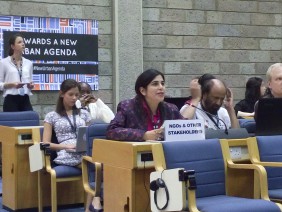by Shipra Narang Suri, Vice President ISOCARP
S-G of the Habitat III conference Dr. Clos, co-chairs of the Bureau, member state representatives, representatives from major groups and observers. My name is Shipra Narang Suri and I am the Vice President of ISOCARP, which is the International Society of City and Regional Planners, with members from 80+ countries, established 50 years ago. We played an important role in Habitat II and defining the Habitat Agenda, as well as in setting up the Habitat Professionals Forum thereafter, a platform that brings together associations of all key professions relating to habitat and human sttlements. ISOCARP currently chairs the Habitat Professionals Forum. We also co-chair the World Urban Campaign, with its 113 lead and associate partners advocating collectively for a more sustainable and inclusive urbanisation.
Over the next eighteen months, the future course of development of our cities and human settlements will be determined. We have a unique opportunity to influence this direction, based on the extensive knowledge, the wide range of experiences and the variety of urban solutions that different stakeholders bring to the table. In both the process and outcome of Habitat III, ISOCARP strongly advocates for a central role for planning and planners. The planning profession has been on the decline for many years, in part due to its own limitations in addressing the emerging challenges of rapid urbanisation, poverty and migration, climate change, disaster risk, conflict etc., but also in no small measure due to the shrinking political space for planning, globally and in many countries. Instead of the central role that planning can and should play, in national and local policy-making, in the rational and equitable allocation of scarce resources to competing priorities, in ensuring that public good takes priority over private interest, and in mediation and resolution of differences and conflicts among stakeholders, planners are restricted to simply offering technical, design or regulatory solutions. This must change globally, and the New Urban Agenda should ensure that planning is used to its fullest potential, as a strategic and transformative tool, by international, national, regional and local actors, in the post-Habitat III era. The International Guidelines on Urban and Territorial Planning, developed by UN-HABITAT with the support of ISOCARP and through a broad-based consultative process, can be an important tool to guide the evolution of planning systems, approaches, strategies and outcomes in both developing and developed world, and must find a central place in the New Urban Agenda, with adequate resources assigned to support and monitor their implementation.
ISOCARP has set up a working group composed of a committed and representative group of its members, to develop a position towards Habitat III. I would also like to mention that ISOCARP has been elected to Chair the group of professionals in the newly established General Assembly of Partners (GAP) towards Habitat III. The General Assembly of Partners aims to bring forth, in a harmonised and streamlined way, the views of all major groups of non-governmental stakeholders, in the Habitat III process and its outcome, the New Urban Agenda. GAP has 14 Partner Constituent Groups, each with its own strategy to reach out and collect the widest possible range of views, experiences and solutions. These will be synthesised in a document that we hope would inform the New Urban Agenda.
On behalf of ISOCARP and GAP, I would like to urge member states to recognise GAP as a key mechanism for stakeholder involvement in the Habitat III process and acknowledge the outcomes and collective positions emerging from this process. I also call on them to engage all stakeholders, including city and regional planners, in both formal and informal dialogue as part of the deliberations towards Habitat III, and to support the General Assembly through all available means.
I thank you for your attention.